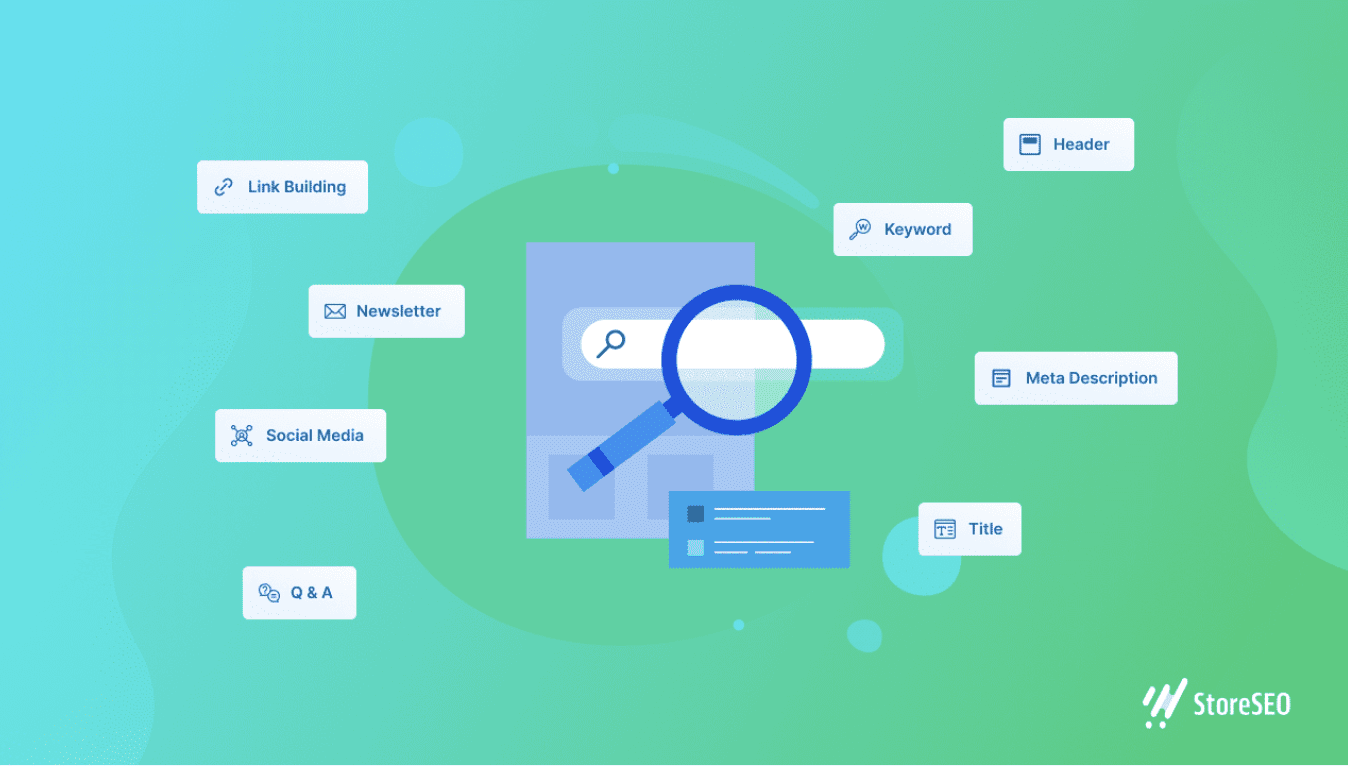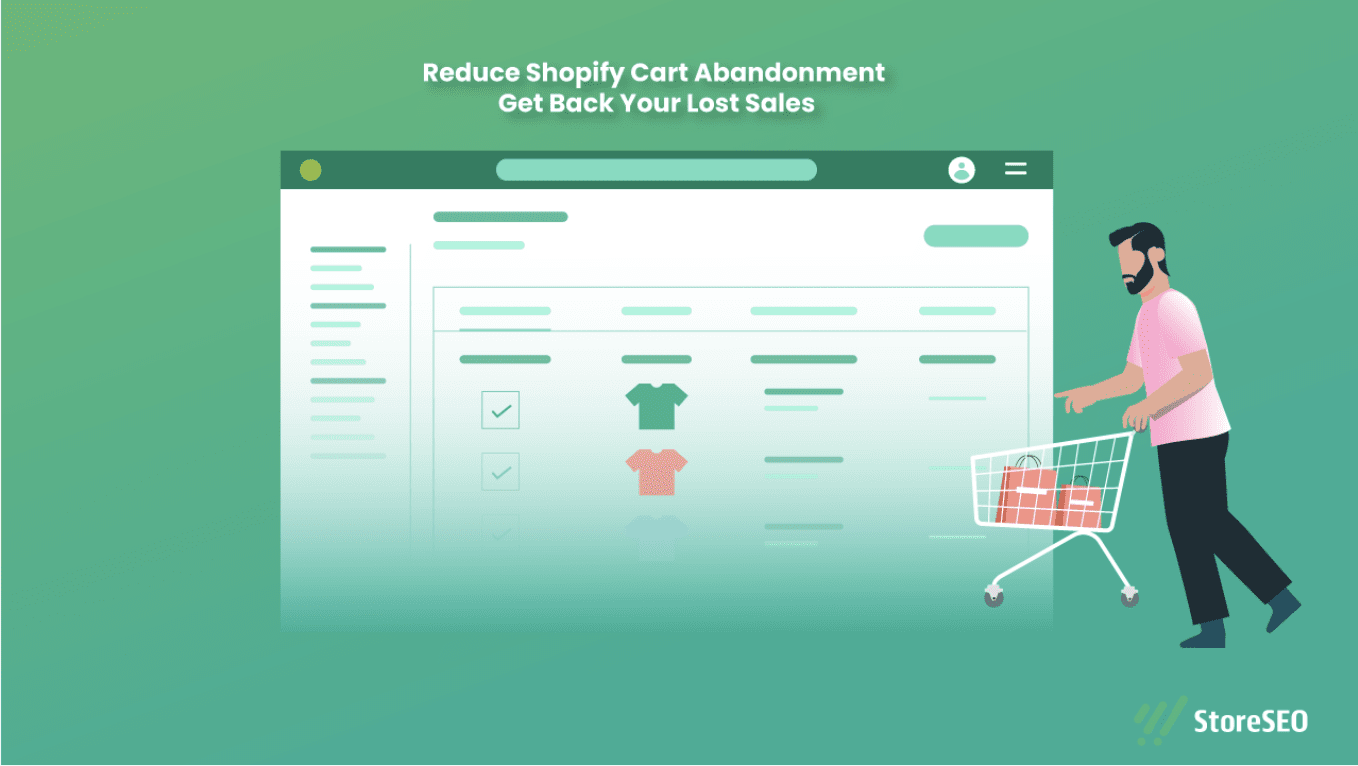あなたの理解 電子商取引の顧客ジャーニー は、オンライン コマースの熾烈な競争の世界で Shopify ストアを成功させる上で不可欠です。カスタマー ジャーニーとは、潜在的な顧客が初めてあなたのビジネスを認識してから熱心な支持者になるまでのステップを表します。このジャーニーの各段階を理解することで、マーケティング活動をカスタマイズし、最終的にコンバージョンを高めてリピート ビジネスを促進する独自のエクスペリエンスを提供できるようになります。

Shopify ストアオーナーのための E コマース カスタマー ジャーニーのマッピング
と ショッピファイ、 の1つ 最高のeコマースプラットフォーム、ビジネスオーナーや起業家はオンラインストアを簡単に立ち上げ、管理できます。Shopifyは顧客の行動、好み、ビジネスとのやり取りに関する分析情報を提供するため、さまざまなツールや機能を使用してeコマースの顧客ジャーニーをマッピングするための優れたプラットフォームになります。このブログでは、 電子商取引の顧客ジャーニーのマッピング Shopify ストアオーナー向けの完全なガイドを提供します。
Statistaによると、2023年7月現在、 「Shopifyは10.23%のeコマースを所有しています 世界中で市場シェアを獲得。
まず、顧客の認知度を高める
電子商取引の顧客ジャーニーは、認知段階から始まります。この期間中に、潜在顧客はあなたのブランド、製品、またはサービスについて学びます。明確な購入意思はまだ必要かもしれませんが、彼らは常に選択肢を探り、ニーズに合ったソリューションを見つけることに前向きです。
もっと詳しく知る: Shopify のベスト eコマーステーマ トップ 10 [2023]
検索エンジンの結果:
適切な検索結果に表示されることは、eコマースの顧客ジャーニーの潜在的な購入者の注意をShopifyビジネスに引き付けるために不可欠です。Shopifyストアは完全にSEO最適化されている必要があります。そのためには、 StoreSEOアプリ Shopify ストアの SEO を設定し、潜在的な顧客がすぐに利用できるようにすると同時に、サイトの SEO を簡単に最適化できます。
ソーシャルメディア活動:
ソーシャル メディアでの積極的な活動と興味深いコンテンツは、顧客を店舗に引き寄せることができます。潜在的な顧客に連絡するには、Facebook、Instagram などのソーシャル メディア サイトでターゲットを絞った広告を使用します。
インフルエンサーと口コミ:
インフルエンサーと協力したり、良い口コミを利用したりすることで、ブランド認知度を高め、彼らのフォロワーにビジネスを売り込むことができます。したがって、この戦術は、eコマースの顧客ジャーニーを次のレベルに引き上げるのに役立ちます。
コンテンツマーケティング:
ターゲット ユーザーの悩みや関心に対応する、価値ある有益なコンテンツを作成します。これにより、e コマース ストアの SEO 最適化が強化され、サイトの価値が高まり、潜在的な顧客を簡単に獲得できるようになります。
チェックしてください: 50以上の最新のShopify統計 2023年に知っておくべきこと
顧客の検討段階に合わせた計画を立てる

潜在顧客はニーズを決定し、積極的に可能性を調査して検討しています。彼らは、あなたの製品やサービスの機能、コスト、レビューを競合他社のものと比較しています。
ウェブサイトの製品ページ:
商品ページでは、包括的な情報と高品質の画像を提供するようにしてください。ここで、Shopify ストアの顧客の注目を集めることができます。
顧客レビューと証言:
肯定的なレビューや推薦文は、顧客の購入決定に影響を与え、eコマースの顧客体験を向上させることができます。
メールマーケティング:
関心のある製品を紹介するターゲットを絞ったメール キャンペーンで、潜在顧客の関心を維持します。さらに、顧客の閲覧および購入行動に基づいて、パーソナライズされた製品の推奨事項を送信します。
もっと詳しく知る: 検索意図とSEO: Shopify ストアのクイックガイド
製品ビデオとデモ:
製品の機能と利点を紹介する魅力的なビデオを作成して、eコマースの顧客の注目を一目で引き付けます。
顧客レビューと証言:
満足した顧客からの肯定的なフィードバックを強調して信頼を築き、ビジネスの信頼性を高めます。
もっと詳しく知る: 20 の驚くべき電子商取引統計 ビジネスを成長させるために知っておくべきこと
店舗のコンバージョン率の向上に注意を払う

コンバージョン段階は、潜在的な顧客が購入を決定する決定的な瞬間です。彼らはあなたの製品に興味を持っている段階から、行動を起こして取引を行う段階に進んでいます。
明確で説得力のあるCTA:
目立つ説得力のある行動喚起を使用して、Web サイトでのコンバージョンを促進します。説得力のある行動喚起は、顧客の注意を簡単に引き付け、コンバージョンを促すことができます。
合理化されたチェックアウトプロセス:
チェックアウト プロセスを簡素化して、カートの放棄を減らします。チェックアウトを簡単にすると、より多くの潜在顧客がすぐに商品を購入するようになります。また、放棄されたカートを回復し、購入完了を促す戦略も実装する必要があります。
もっと詳しく知る: Shopify 放棄されたカート: 理由、ハック、ヒントなど
期間限定オファー:
期間限定の割引やプロモーションで緊迫感を演出します。eコマースの顧客に特別なオファーを提供し、ビジネスへの関心を高めて売上を伸ばすことができます。
送料無料:
頻繁に購入を促すために、送料無料または割引配送を提供してください。そうすれば、顧客はそのオファーを心待ちにして、つながりを持つようになります。これにより、手間をかけずに e コマースの顧客ジャーニーが促進されます。
顧客の購入後の体験を評価する

購入後、顧客は購入後の段階に入ります。この段階では、顧客満足度の確保、リピート購入の促進、ブランドロイヤルティの構築に重点が置かれます。
注文確認とお礼のメール:
感謝の気持ちを伝え、期待を持たせるために、パーソナライズされた注文確認メールやサンキュー メールを送信します。このような継続的な感謝メールを通じて、顧客の満足感を高めることができます。
アップセルとクロスセルのテクニック:
平均注文額を増やすために補完的な製品を提案します。アップセルとクロスセルのテクニックは、顧客にとっての価値を最大化しながら、顧客のショッピング体験を向上させることに重点を置いています。
顧客サポートとフォローアップ:
あらゆる問題や懸念に対処するために、優れたカスタマー サポートとフォローアップを提供します。専任チームを管理することで、問題解決だけにとどまらない優れたカスタマー サポートにより、顧客と積極的に関わり、懸念に共感し、効果的なソリューションを迅速に提供して、当社のブランドに対する顧客の満足と信頼を確保します。
購入後のパーソナライズ
感謝のメールには、顧客の名前を使用したり、購入した製品について言及したりすることで、簡単に個人的なタッチを加えることができます。これにより、顧客に価値があり特別な存在であると感じさせることができます。
顧客にインセンティブを与えてブランド支持を強化

支持段階では、満足した顧客がブランドの支持者になります。彼らはポジティブな体験をネットワークで共有し、有機的な成長と新規顧客の獲得につながります。
紹介プログラムとインセンティブ:
お客様が他のお客様をあなたのストアに紹介してくれた場合に報酬を与える紹介プログラムを作成します。お客様が他のお客様を私たちのストアに紹介すると、お客様はあなたの製品やサービスを発見した喜びを共有するだけでなく、感謝の印として魅力的なインセンティブや特別な報酬を受け取ります。
ユーザー生成コンテンツ キャンペーン:
ユーザー生成コンテンツを通じて、顧客に体験を共有するよう促します。熱心なユーザーのコミュニティを育成し、コンテンツ キャンペーンを通じて顧客が貴重な瞬間を共有すれば、ブランドを本当に特別なものにしている声を称賛するのに役立ちます。
顧客スポットライト:
ウェブサイトやソーシャル メディアで忠実な顧客を強調し、彼らの忠誠心とサポートをアピールしましょう。ブランドに対する彼らの揺るぎないサポートと信頼は、卓越性を追求し続け、その見返りとして最高の製品やサービスを提供する大きな動機となります。
ソーシャル メディア コンテスト:
顧客が体験を共有し、ブランドにタグを付けて賞品を獲得するチャンスを得られるコンテストを開催します。これにより、熱心な顧客について知ることができ、さまざまな方法で顧客に報酬を与えてブランドの品質を向上させることができます。
ツールと分析機能で顧客体験を追跡・測定

顧客行動を追跡して分析することは、データに基づいた意思決定を行い、Shopify ストアのパフォーマンスを最適化するために不可欠です。
Google アナリティクス:
ウェブサイトのトラフィック、ユーザーの行動、コンバージョン率に関する洞察を得ることができます。Shopify ストアを Google アナリティクスに統合するだけで、手間をかけずにサイト全体のパフォーマンスを把握できます。
Shopify アナリティクスダッシュボード:
Shopify の組み込み分析機能を活用して、ストアのパフォーマンスと売上を監視します。また、Shopify の組み込み分析機能を通じてオーナーとしてストアの顧客体験を監視し、サイトのパフォーマンスを向上させる計画を立てることもできます。
カスタマージャーニーマッピングツール:
それ以外にも、問題点や改善点を特定するためのさまざまなカスタマー ジャーニー マッピング ツールが利用可能です。いずれかを選択して、事前にサイトのパフォーマンスの追跡と監視を開始できます。
SEO アプリを使用した高度な SEO 結果:
Shopify SEOアプリに組み込まれた高度な分析機能により、手間をかけずにストアのSEOを改善できます。前述のように、 ストアSEOこのソリューションを使用して、eコマースの顧客ジャーニーをすぐに拡大することができます。
もっと詳しく知る: ShopifyストアのSEOスコアを100にする方法 2023年にStoreSEOを導入しますか?
ケーススタディに焦点を当てて信頼性を高める
ケーススタディを見る Shopifyストアオーナー カスタマー ジャーニーを効果的にマッピングし、注目すべき成果を達成した成功事例を紹介します。また、成功事例から貴重な教訓と実用的な洞察を抽出し、自分の Shopify ストアに適用します。
Shopifyストアオーナーにこれらの戦略を実装するよう奨励
購入プロセスのあらゆる段階で顧客と交流するために、 電子商取引の顧客行動を理解する 成功するShopifyストアを運営する上で重要な要素です。
顧客満足度の向上、コンバージョン率の向上、そして永続的なブランドロイヤルティの維持は、 カスタマージャーニーマッピングのアイデア 実践しましょう。顧客の旅を受け入れて、最初から最後まで顧客の旅を簡単で楽しいものにしましょう。
のマッピング 電子商取引の顧客ジャーニー したがって、Shopify サイトのマッピングは、継続的な学習と最適化の取り組みです。各レベルの顧客の特定の要求と好みに対応することで、成功するオンライン ビジネスを確立し、熱心な顧客基盤を構築できます。e コマース事業の成功とマッピングの成功をお祈りします。
この投稿を気に入っていただけましたか? ブログを購読する もっと楽しいチュートリアルをご覧になりたい方は、フレンドリーな Facebookコミュニティ.









